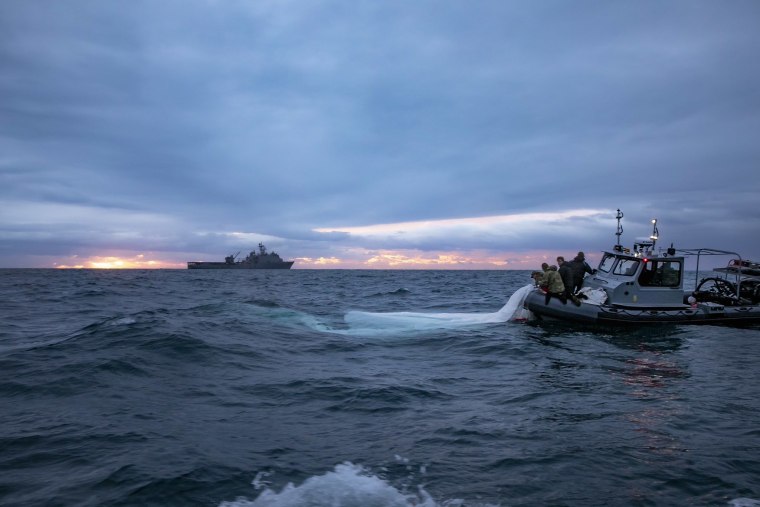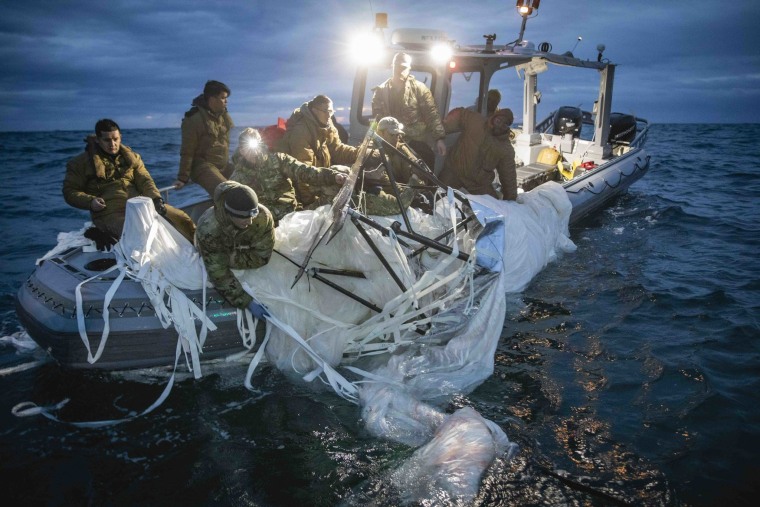It was a troubling claim made by a key member of Congress with access to top secret information: If you plotted the trajectory of the Chinese spy balloon, it’d mirror where the nation's most sensitive and powerful weapons are stored.
“If you ask somebody to draw an X at every place where our sensitive missile defense sites, our nuclear weapons infrastructure, our nuclear weapon sites are, you would put them all along this path,” Rep. Mike Turner, the Republican chairman of the House Intelligence Committee, said Sunday on NBC News' “Meet the Press.”
In some ways, Turner appears to be correct, according to the experts who keep tabs on where those weapons are stored.
The high-altitude surveillance balloon was spotted lingering near Malmstrom Air Force Base in Montana, where the U.S. stores a portion of its land-based nuclear weapons in more than 150 missile silos, according to the Federation of American Scientists’ Nuclear Information Project.
The balloon also made its way close to Offutt Air Force Base near Omaha, Nebraska, according to sightings. Offutt is the home of U.S. Strategic Command, which is in charge of the country’s nuclear forces.
It also came close to Missouri's Whiteman Air Force Base, according to Sen. Eric Schmitt, R-Mo. The base is home to the B-2 stealth bomber, which can drop conventional as well as thermonuclear weapons.
A U.S. official, speaking on condition of anonymity, acknowledged the balloon did fly over some sensitive bases, but the U.S. believes it did not have the ability to collect information beyond what China already does through its sophisticated spy satellites.
Even civilian satellites can provide a fairly good image of the country's nuclear sites, according to Hans Kristensen, the director of the Nuclear Information Project.
"We can sit on Google Earth and go over very high-resolution imagery of every single missile silo in Montana and the status of construction at Offutt Air Force Base and all that stuff,” he said. “There’s so much information already in the public domain that it would have to be something extraordinarily unique for them to glean anything visual.”
The balloon didn't appear to visit all of the nation's known nuclear arsenals.
It did not seem to venture close to Minot Air Force Base in North Dakota or Warren Air Force Base, which stretches through Wyoming, Colorado and Nebraska. It appeared to have threaded a fairly wide geographic needle between those two military bases that each boast more than 150 missile silos for the U.S. nuclear stockpile, according to the Nuclear Information Project.
It remains unclear what the balloon could have gleaned that the Chinese could not have uncovered with traditional satellite imagery, experts said, or what surveillance capabilities the balloon may have had. The U.S. military is working to recover the remnants of the balloon in the Atlantic Ocean after an American F-22 Raptor shot it down Saturday afternoon with a missile.

Kristensen speculated that the balloon, because of its large size, could have carried special surveillance equipment that would pick up details and frequencies that are off the visual spectrum, but he emphasized that it is unknown whether the balloon had those capabilities.
China has insisted the balloon was not meant for spying, but instead intended to collect weather information and got blown off course. The U.S. has dismissed that assertion.
State Department spokesperson Ned Price said at a briefing Monday that the U.S. had “taken practical steps since the time this high-altitude surveillance balloon was detected to mitigate its ability to collect intelligence against sensitive sites, to mitigate any threat it can pose to the American people.”
As the remnants of the balloon are collected from the Atlantic, Price said the episode has allowed the U.S. to learn quite a bit about the technology that it carried, as well as China's surveillance practices. That sentiment was shared by Gen. Glen VanHerck, commander of U.S. Northern Command, who told reporters Monday that the U.S. waited to destroy the balloon because they were gathering intelligence on the inflatable's capabilities.
"This gave us the opportunity to assess what they were actually doing, what kind of capabilities existed on the balloon, what kind of transmission capabilities existed," he said, "and I think you’ll see in the future that the time frame was well worth its value to collect over."
Still, lawmakers have demanded answers. Sen. Steve Daines, R-Mont., sent a letter to Secretary of Defense Lloyd Austin demanding a security briefing from the administration, given the balloon's sighting near Malmstrom Air Force Base.
“The fact that this balloon was occupying Montana airspace creates significant concern that Malmstrom Air Force Base (AFB) and the United States’ intercontinental ballistic missile (ICBM) fields are the target of this intelligence gathering mission,” Daines wrote.
The nuclear bases also are known to have their own defenses to ensure necessary secrecy, which would undermine most surveillance efforts, Kristensen said.
"When it comes to these nuclear bases, they're designed to be very difficult to pick up information from in terms of their operation and communications," he said. "They operate on secure systems."

